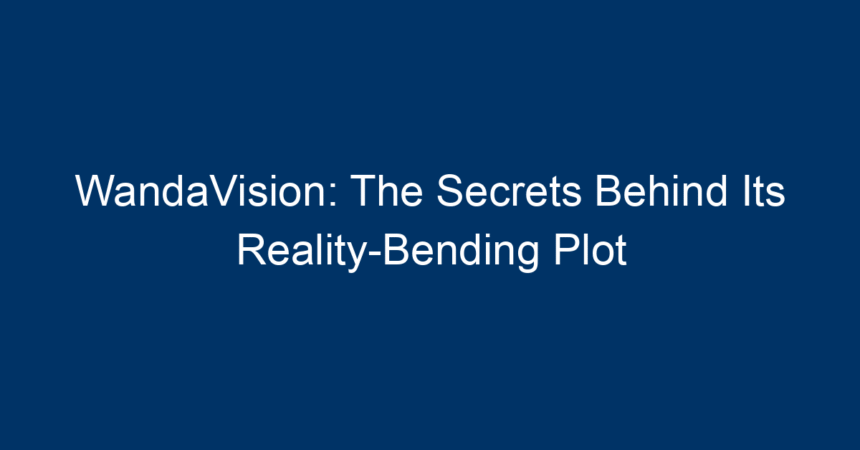Introduction
Marvel’s WandaVision has become a cultural phenomenon since its debut on Disney+. Combining classic sitcom aesthetics with the complex lore of the Marvel Cinematic Universe (MCU), this series has captivated audiences with its intricate storytelling and emotional depth. But what lies beneath the surface of its reality-bending plot? In this article, we will unravel the secrets behind WandaVision‘s narrative, exploring its themes, characters, and the clever techniques employed to keep viewers guessing.
The Blend of Genres: Sitcoms and Superheroes
One of the most striking features of WandaVision is its unique blend of genres. The show begins with the couple living the ideal suburban life reminiscent of classic sitcoms, such as The Dick Van Dyke Show and Bewitched. This setting serves two purposes: it captures the nostalgia of viewers and provides a stark contrast to the darkness lurking beneath.
Nostalgia and Emotional Resonance
The choice to present the narrative through a sitcom lens is a brilliant tactic, allowing audiences to engage with Wanda and Vision’s relationship in a light-hearted environment. However, as the show progresses, the transition from sunshine and laughter to horror and grief becomes increasingly evident. The juxtaposition of these styles invites viewers to explore deeper themes of love, loss, and acceptance, setting WandaVision apart from traditional superhero stories.
Characters at the Heart of the Narrative
Wanda Maximoff: A Complex Protagonist
At the center of WandaVision stands Wanda Maximoff, played masterfully by Elizabeth Olsen. Her journey through grief and trauma is the emotional core of the series. Following the devastating events of Avengers: Endgame, Wanda is depicted grappling with immense loss. The reality she creates serves as a coping mechanism, illustrating how grief can alter one’s perception of reality.
Vision: More Than Just a Sidekick
Paul Bettany’s Vision is more than just Wanda’s love interest; he represents the ongoing struggle between what is real and what is fabricated. As he begins to become aware of the inconsistencies in their reality, his character embodies the tension between blissful ignorance and painful truth. This duality adds layers to both characters, making their narrative even more compelling.
The Role of Supporting Characters
Agatha Harkness: The Master Manipulator
One of the standout characters in WandaVision is Agatha Harkness, portrayed by Kathryn Hahn. Initially presented as a nosy neighbor, Agatha quickly reveals herself to be a powerful witch with her own agenda. Her character serves as both an antagonist and a mentor, providing crucial lessons in control and power. Agatha’s famous line, “It was all Agatha all along,” not only becomes a fan favorite but also highlights the art of misdirection woven throughout the series.
The Supporting Cast: Darlings and Distractions
From Monica Rambeau (Teyonah Parris) to Jimmy Woo (Randall Park) and Darcy Lewis (Kat Dennings), supporting characters embellish the narrative by enriching the world of Westview. Their involvement allows for the exploration of alternate realities and speaks volumes about Wanda’s influence over those around her.
Reality-Bending Techniques in Storytelling
The Use of Time and Structure
WandaVision skillfully employs a non-linear narrative structure that mirrors its sitcom heritage. Each episode serves as a different homage to decades of television, spanning from the 1950s to the present day. This creative choice not only enriches the viewing experience but underscores Wanda’s mental state and her desire to create an idyllic life.
Breakdowns of Reality: Clues for the Curious Viewer
While WandaVision is laden with mystery, it leaves breadcrumbs for viewers to piece together its underlying secrets. Subtle hints, Easter eggs, and visual storytelling converge to create an immersive experience. Fans have dissected every frame, leading to theories and discussions that fuel community engagement. Attention to detail, such as the changing color of the helicopter or the ominous presence of the S.W.O.R.D. organization, adds depth to the overall narrative.
Cinematic Techniques: Visual Cues and Symbolism
The show’s cinematography plays a vital role in conveying emotion. Through lighting, color palettes, and camera angles, the creators guide viewers’ experiences. For instance, the transition from monochrome to vibrant color marks significant shifts in Wanda’s emotional landscape. Symbolic elements, like the recurring use of the hexagonal shape, illustrate the complexities of Wanda’s constructed reality.
Themes Explored in WandaVision
Grief and Trauma
At its core, WandaVision is a profound meditation on grief. Wanda’s attempts to resurrect her lost love in a fabricated world speak to the lengths one might go to avoid facing painful truths. The series ventures into how trauma can distort one’s perception and lead to unhealthy coping mechanisms.
Identity and Self-Discovery
As Wanda navigates her alternate reality, she begins to confront her identity as both a superhero and a woman grappling with her own demons. Episodes such as “Breaking the Fourth Wall” highlight her struggles with self-realization, revealing a journey towards embracing her true self.
Community and Connection
Another poignant theme is the importance of community. The dynamics within Westview serve as a microcosm of societal connections, reflecting how people can become trapped in their roles. The residents’ suffering at the hands of Wanda’s grief brings to light the repercussions of isolation and the longing for genuine connection.
The Future of WandaVision
Setting the Stage for the MCU
WandaVision is not just a standalone series; it establishes critical groundwork for the future of the MCU. The exploration of chaos magic and the introduction of characters like Agatha Harkness set the stage for, not just upcoming films, but also series like Doctor Strange in the Multiverse of Madness. Wanda’s transformation into the Scarlet Witch promises a deeper dive into her powers and their implications for the MCU.
Fan Theories and Speculation
The ending of WandaVision left fans with many questions, fueling speculation and theory crafting across social media and forums. Will Wanda create a new reality in her pursuit of love? How will her relationship with Doctor Strange evolve? These open-ended questions ensure that WandaVision‘s legacy will endure, inviting analysis and discussion for years to come.
Conclusion: Embracing Complexity in Storytelling
WandaVision has redefined what it means to be a superhero show, blending humor, heart, and horror to craft a narrative as complex as its protagonists. By exploring themes of grief, identity, and community, the series shines a light on human experiences that resonate far beyond the realm of comic books.
Whether you are a casual viewer or a die-hard Marvel fan, engaging with WandaVision offers a unique opportunity to delve into the complexities of its storytelling. By dissecting its themes and characters, we can better understand not just the show itself, but also the larger MCU narrative.
In the end, WandaVision serves as a testament to the power of storytelling—challenging us to confront our realities, embrace our identities, and connect with one another in meaningful ways. So, grab your favorite snack, revisit that hex, and immerse yourself once again in this unforgettable journey through love, loss, and the extraordinary realms of the mind.




